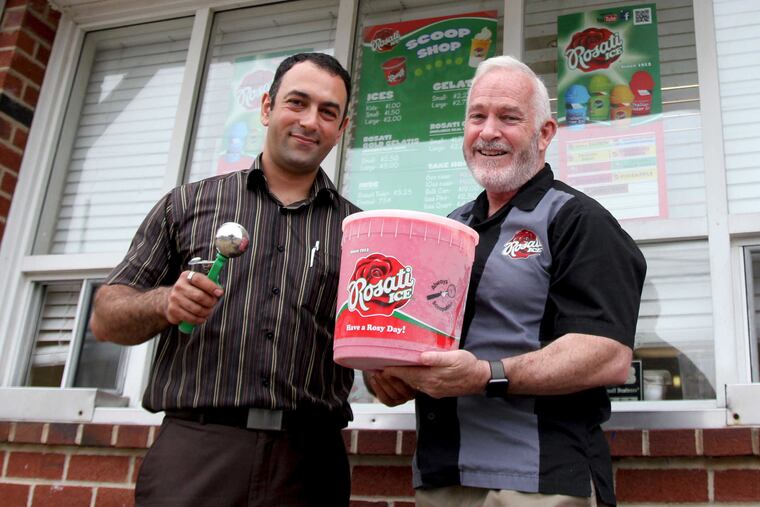At Rosati, they have water ice down cold
In the old days of the water ice business, "you made a gob of money in the summer, you lost a gob of money in the winter. If the gob in the summer was bigger than the gob in the winter, you had a good year. I wasn't really comfortable with that model," says owner Rich Trotter.

With the calendar reading June, you might imagine this is the start of the big season for Rosati Ice, which has been making water ice since 1912. Actually, fall and winter are far busier at the modest brick factory tucked into a largely residential Delaware County neighborhood since the mid-'50s. You also might think a traditional flavor such as cherry, lemon, or chocolate would be Rosati's best seller. No, says the president, Rich Trotter. It's mango — by a wide margin. And third, you might expect a frozen-food plant that can crank out 150,000 cups of water ice in a 10-hour shift would at least have a loading dock. Also, no.
Rosati's water ice is everywhere — particularly at Acme and Weis Markets, which sell cups and containers, and at corner grocery stores and "ding-a-ling" trucks, which scoop per order. There's also a walk-up window at the factory for its neighborhood customers. But Rosati's bread and butter is now the school trade; a recent reformulation transformed Rosati's from a solid-packed icy brick to a scoopable dessert as it became, according to federal nutritional standards, a serving of fruit.
Trotter, 61, laid out the business, with vice president of operations Hamed Seresty, 34, who runs the plant, standing by. Rosati is a United Nations. Signs in Vietnamese guide rank-and-file workers. Seresty is from Iran. Production manager Kabe Massire is from Mali. Warehouse manager Louis DiGiacomo is a U.S. Marine veteran who was wounded in Somalia. "We don't look at ourselves as diverse," Trotter said. "We look at ourselves as, we're a single mind, single heart, good people, honest people, and it's been great for the business, and it's been great in terms of attracting the next wave of new talent that we're looking to bring on as we can afford it."
Tell me about the business of water ice.
When we bought the business in '97, the model was you made a gob of money in the summer, you lost a gob of money in the winter. If the gob in the summer was bigger than the gob in the winter, you had a good year. I wasn't really comfortable with that model, so one of my missions was to try and change the revenue stream and fill up the valleys a little bit. More than 50 percent of my sales right now are K-to-12 schools. When we bought the business, the schools were starting to move away from sugar products and starting to go to juice-based products. We put our focus on developing a product that would meet a fruit requirement on the school lunch program. We've grown our school segment to where we're literally all over the country. We actually in the last couple of years have done more business in October, November, December than we have done in June, July, and August.
Hamed, how did you get to Clifton Heights?
I found this job through an ad on Craigslist. I didn't know what kind of job I was getting into. I had no idea what Italian ice is. The first day that I got here, we were making a Typhoon cone cup, and that was the first ice that I tried. It was blue raspberry lemonade. This was a new experience. I'd had ice cream for my whole life, but I didn't have water ice. First, I didn't know when it said "Italian ice" or "water ice." I was thinking we are making ice cubes here.
Rich, what's new here?
We make an Italian ice made out of coconut water concentrate, so the nutritionals on that match up well for the Whole Foods crowd. It's all good stuff. It's dairy-free, gluten-free, fat-free, cholesterol-free, no high-fructose corn syrup, and naturally colored and flavored. The reason we can do something like this is because of the people that we have around us. Al Everetts, our vice president of great taste, had his own business for a long time, sold it, was out of circulation for a couple of years. I got Al back in, and I gave Al free rein to change our formulations. He's like an old country doctor when it comes to formulations. He also developed a product that's made specifically for the Mexicano crowd here in the U.S., and it's called mangoñeada. It's mango swirled with chili pepper sauce.
Top flavors?
Believe it or not, over the last 10 years, mango has risen. When I bought the business, it might have been the 10th top-selling flavor. For the last 10 years, it's been number one for us. Second is cherry. Third is a toss-up between lemon and blue raspberry. Your lemon is very popular with guys my age, people my age, and blue raspberry, obviously, is a popular one for the kids.
Are you going to have to move the plant?
At some point in time, we will. We're probably looking at like a 40,000-, 50,000-square-foot facility. We're looking for an area where, for efficiency purposes, we can receive at one end — ingredients, supplies — and we can flow the manufacturing, and then have a freezer at the other end and then have a loading dock to where the product can go out. Sam built this place smartly for a million-plus business. Once we got to three or four million … We don't have any loading docks here, no loading docks. That's the challenge of our warehouse manager. In a lot of ways, we operate like it's the 1960s.